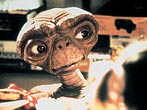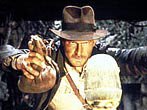

"Close Encounters of the Third Kind" (1977): At the heart of any Spielberg film is faith – not simple religious faith, but rather faith in imagination, faith in magic, faith in the unknown. This film epitomizes that as we watch Richard Dreyfuss’ Roy Neary sculpt Wyoming’s Devil’s Tower in everything from shaving cream to mashed potatoes. Roy abandons his humdrum, suburban life to pursue the idea that perhaps there is intelligent life on other planets, and there’s a recklessness to his actions that’s invigorating – and missing from a lot of later Spielberg films. A determination to know drives him – and it’s the perfect metaphor for an artist like Spielberg, who sees visions of the fantastic in his head and strives to make them real.


"Jaws" (1975): Spielberg never had a better collaborator than Richard Dreyfuss (sorry, Tom Hanks). The two invigorated each other – with Dreyfuss’ wound-up personality the on-screen equivalent of Spielberg’s lofty ambition. Here, the two usher in the era of the blockbuster in this story of three men who go in search of a great white shark on a boat that’s not quite big enough. The movie terrifies with what it doesn’t show, and yet it never abandons its characters for the sake of plot. One of the film’s best moments comes when Quint (Robert Shaw) tells the story of the sinking of USS Indianapolis. It’s a horrifying, human moment that makes this more than a simple horror film. Yeah, ultimately Bruce the shark looks pretty fake, but with three strong performances (Dreyfuss, Shaw and Roy Schneider), Spielberg proves that effects come in second place to great acting.


"Schindler’s List" (1992): Though it would have been nice if Spielberg’s Holocaust story centered on a character who was Jewish, it’s still hard not to be moved by this story of Oskar Schindler (Liam Neeson), a man who finds his own humanity in one of history’s darkest hours. Unlike some of his attempts at dramatic films ("Saving Private Ryan," "The Color Purple"), this film avoids becoming simple melodrama, primarily because Spielberg starts with a character who is flawed to begin with – and because he uses actors like Ben Kingsley and Ralph Fiennes, who layer their performances so they are not simple pictures of good and evil. You can feel Spielberg’s heart in this film, but luckily none of the characters wears it on their sleeves.


"E.T. The Extra-Terrestrial" (1982): This boy-meets-alien story comes across like a modern fairy tale – and feels told specifically from a child’s point of view. The decisions Elliot (Henry Thomas) makes, from drawing the alien out with Reese’s Pieces to dressing him up for Halloween are ideas only a boy his age would come up with. With the film’s single mom and absentee dad, it also felt like the perfect picture of suburban middle-class life in the 1980s. And if you didn’t cry when you thought E.T. might not make it, you’re made of stronger stuff than I was at age 14. Yes, Spielberg blatantly pulls heart strings in this film, but he does it with such panache that your only choice is to lean back and let him have his way with you.


"Raiders of the Lost Ark" (1981): Before we found out he was named for the family dog or met the truly annoying Short Round, Indiana Jones was cool. He fought thoroughly-acceptable and non-controversial villains (the Nazis). He taught archeology, while running from giant boulders for his side gig in artifacts recovery. This film (unlike those that followed) thrives on imagination, wit and great performances from Harrison Ford, and especially Karen Allen as the feisty Marion Ravenwood. Allen showed that female characters could do more than scream (yes, Kate Capshaw, that means you) and she proved the perfect counterpart for Ford. Though this film barely beats out "Catch Me If You Can" and "Munich," it makes the list simply because it revels in its own sense of fun and adventure.
Taken From http://www.msnbc.msn.com/id/10723946/
No comments:
Post a Comment